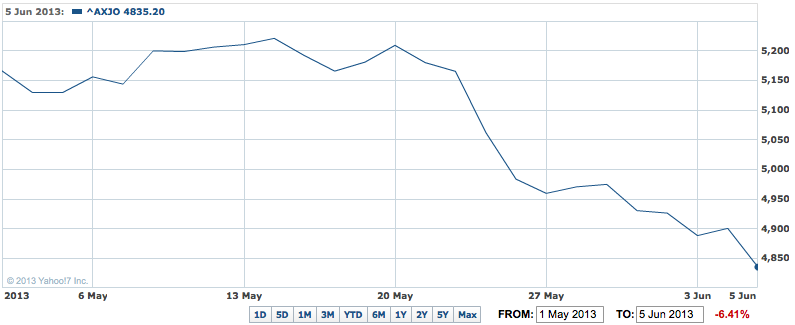The fall in the market last month and so far in June, is getting close to wiping out the gains for the current year.
Yesterday saw an initial sell down off the back of the 200 plus fall on Wall Street. There was a partial rebound midway through the day’s trading, and then a late slide.
The ASX/200 fell more than 50 points, or 1.1% to just under 4,781 points. The All Ords was down by the same amount to 4771.
At its recent peak on May 14, the ASX200 was up nearly 12%, meaning around $121 billion has been lost in market value over the three weeks.
XAO From May 1 – Miserable May & Jittery June

Some analysts blame the falling dollar for part of the fall in the stock market since early May, but that’s not the only factor at work.
Other culprits are the Japanese share market boom – and the fall in the value of yen – which are now reversing as the market falls and the yen edges higher.
In fact the rise in the yen overnight will hit the Japanese market hard today. That could rattle markets in the region, as it did last week and the week before.
US markets saw small gains, but the big fall in the greenback confused investors ahead of the release tonight of those jobs figures for May which will drive the market’s immediate direction.
When you take that, along with rising concerns among flighty US investors about the impact of a slowing in the Federal reserve’s huge spending program, you have a recipe for volatile market trading conditions.
Not helping has been reports of huge losses among hedge funds and other investors specialising in fixed interest securities, thanks to the 0.60% rise in US bond yields in the past three weeks, and a sharp rise in japanese yields.
The 13% plus correction in the Tokyo stockmarket in the past three weeks has also hit some big global investors hard, causing losses.
So also is the fact that three of the big four banks and dividend machines have now revealed their March 31 interim profits and lifted dividends, declared them and gone ex dividend, meaning the big attraction for some investors has disappeared.
Bank shares (and Telstra) drove much of the big run in March and April and into mid-May.
Telstra shares are down sharply as well – from $5.15 to around $4.60.
That’s a fall of more than 10% and mostly down to the upsurge in fears about the financial impact of asbestos in the NBN roll out.
At the same time offshore investors no longer seem as fixated on yield and seem to be looking to invest in low yielding growth stocks as the US markets wait on the Fed decision on its easing program.
Watch for the May US jobs data tonight (our time), it will be an big influence on trading here next week. But our markets are closed Monday for a holiday.
And, remember the big sell off in gold, and then other commodities in April? It now looks like that was an early warning of the slide we are now seeing.
It’s a reminder that gold doesn’t hold any value for investors in times like this when volatility is high and confidence stretched.
On May 14, the ASX/200 hit a 2013 peak of 5220.98, which was up 11.7% for the year so far. Since then it has lost around 8 – 8.5%.
For superfund investors that means the 14% improvement in the year to April (reported by Superratings (http://www.superratings.com.au/media/mediarelease/21052013) last month, has been slashed by more than 50%.
Superratings reported:
"Australian superannuation funds are poised to deliver a near record financial year result to Australians after adding another 2.0% in earnings over the month of April.
"With the 9th positive monthly return this financial year, and with strong May figures yet to come, funds are poised to post their second highest ever one year result since the introduction of compulsory superannuation 21 years ago. In the first 10 months of 2012/13, balanced options have posted a median result of 15.0% and should equity markets remain buoyant between now and June, the majority of Australians will most likely see their fund‟s return eclipse the 15.8% result of 2006/07, but fall short of the record 18.0% returned 16 years ago in 1996/97.
"Markets across the board helped drive strong returns in April, with Australian and International equity options delivering 3.3% and 2.6% for the month respectively; property options jumping by 2.9% whilst Fixed Interest returned 1.2%."
Those ‘strong’ May figures won’t be so strong after the falls of the past three weeks.













